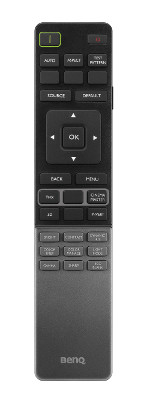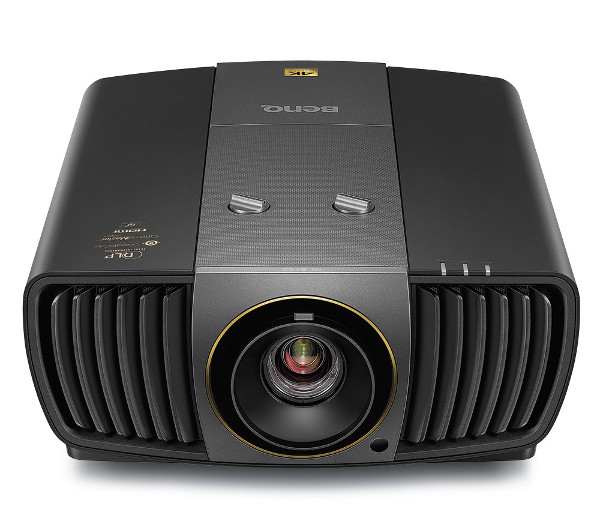BenQ HT9050 4K DLP Projector Review Page 2
Setup and Calibration
Aside from the backlit remote's puzzling, phantom buttons for "Dynamic Iris" and "3D" that perform no real functions, its overall operability was fine, and BenQ’s menu structure was easy enough to navigate. The projector offers a host of picture modes, though none can be accessed directly from the remote. The only one that was truly usable was the Cinema preset.
One of the HT9050's selling points is that it supports the P3 color space. While this may be a draw for the professional studio market (for mastering), there is technically no P3 content for consumers. By this I don't mean that we don't have content mastered out to the limits of the DCI-P3 color space; most UHD Blu-rays are originated from a Digital Cinema Package (DCP) that has been mastered in P3. But UHD HDR content uses a Rec. 2020 envelope, and requires a display that correctly accepts and decodes Rec. 2020 for accurate color. Likewise, regular standard dynamic range HD material is all mastered in the Rec. 709 color space, which all 1080p displays can properly recognize and decode.
 The problem with the HT9050 is that it has no picture modes that are set up to properly recognize Rec. 2020. All of the picture modes for the HT9050 are set up for the P3 color space, except the Cinema mode, which uses Rec. 709. There are no options in the setup menus to change the color space for any of the modes, either. There are some User modes that can employ the Cinema mode as their foundation, though. Since the HT9050 doesn’t support HDR, I only needed to worry about getting one of the preset picture modes set up for standard Rec. 709 content, so it made calibration pretty straightforward.
The problem with the HT9050 is that it has no picture modes that are set up to properly recognize Rec. 2020. All of the picture modes for the HT9050 are set up for the P3 color space, except the Cinema mode, which uses Rec. 709. There are no options in the setup menus to change the color space for any of the modes, either. There are some User modes that can employ the Cinema mode as their foundation, though. Since the HT9050 doesn’t support HDR, I only needed to worry about getting one of the preset picture modes set up for standard Rec. 709 content, so it made calibration pretty straightforward.
Out of the box, the HT9050 was fairly typical when it came to color accuracy for Rec. 709 content, though it could have been better. The setup menu offers selections for both gamma and color temperature, but only the latter could be calibrated. Since the projector had an extremely low contrast ratio, I stuck with a gamma of 2.2. A higher gamma would have required a lower black floor, and I didn’t want to have to worry about black crush. Grayscale out of the box was a bit blue deficient, but the two-point grayscale controls evened things out and delivered an average Delta E error of 2, which is very good (anything below 3 is usually considered undetectable by the eye). Out of the box measurements for the Cinema preset's Rec. 709 color gamut was on the wide side, which is a good thing for pre-calibration.
The standard menus offer a full color management system (CMS) for dialing in the color, and unlike similar controls we sometimes see on other projectors, this one was quite effective. I was able to achieve a very accurate result with an average Delta E of less than 1. Standard settings like brightness and contrast needed little adjustment. However, I recommend leaving the sharpness setting in its default of 6; otherwise, the image softens.
The advanced menu includes a submenu called Cinema Master that provides some image “enhancements,” which mainly overdrive colors for more pop. There’s a setting called Pixel Enhancer 4K, though, that does seem to affect the quality of the XPR chip. When I set this to 0, the image looked very soft. Setting it much higher delivered obvious image-sharpening artifacts. I found that setting this to 1 delivered the best performance with no visible artifacts. This reminded me a lot of the Reality Creation setting on Sony projectors I've tested, which also needed to be judiciously applied to get the best performance from the imaging chip.
Performance
I was pretty excited about getting the chance to see the new DLP chip in action. I’m a firm believer in having as much competition in the market as possible, and the idea that DLP could make it back to this level of the home theater market could only be a good thing. Aside from Sony's recently announced $5,000 budget model (VPL-VW285, review pending), projector manufacturers have been slow in adopting native 4K for the sub-$10,000 market. So my hope was that this new tech would help motivate them to bring true 4K performance to this price point.

Unfortunately, though, my viewing revealed that this BenQ, as it stands with current firmware, won't be the standard bearer for 4K DLP. Putting aside for a moment the poor contrast that makes the picture look far too washed out with the darker images so often found in films, the lack of support for HDR and Rec. 2020-mastered content remain significant drawbacks. Without a doubt, the best images from consumer 4K at the moment rely on HDR. This doesn’t mean that you can’t watch UHD on the HT9050; the source component just has to alter the content to standard dynamic range and Rec. 709 color. All Ultra HD Blu-ray players do this, though how well they do it is very hit or miss at the moment. In my experience, the best performer in this regard so far is the Panasonic DMP-UB900, and that’s what I used with the BenQ projector. The Panasonic player tone-maps the HDR content down to standard dynamic range and delivers Rec. 709 color from the native Rec. 2020 color gamut used on UHD discs.
From the standpoint of resolution and detail, the BenQ looked its best being fed 4K content and was very nearly comparable, subjectively, to true native 4K displays I’ve seen. This is key, given the claims being made by Texas Instruments and the projector manufacturers using this new chip. When I viewed 4K test patterns intended to show pixel-for-pixel resolution, the DLP chip couldn’t match my native 4K displays — whether projection or flat panel. But when I watched normal content, it was closer to my native 4K displays than what I’ve seen from the 1080p pixel-shifting projectors from JVC and Epson on my 120-inch matte white screen.
BenQ says the HT9050 differs from less pricey projectors using the same DLP chip in the quality of its light engine and particularly its lens, which was designed for 4K resolution rather than being a carryover from a pre-existing 1080p projector. It shows. Lucy and John Wick: Chapter 2 are absolute show-off titles for 4K UHD, and the HT9050 delivered fantastic sharpness — though the lack of contrast took a heavy toll on image depth in mid- to lower-brightness scenes, and darker scenes looked gray and washed out.
Bright sequences were definitely where this projector shined, with excellent depth, clarity, and color. Blu-ray titles like Disney’s animated Moana are an excellent showcase for a projector like this, as the image stays bright more often than not. Ultimately, your overall experience of image quality on the HT9050 will probably be swayed one way or another based on the typical brightness levels of the content you watch most often, and perhaps, its relative performance compared with the type of display you're used to viewing.
Conclusion
I’m happy to see next-level LED light engine support from the HT9050, and the new XPR DLP solution does show promise in delivering near-native 4K quality from a non-native-4K imaging device.
But the HT9050 seems like a big missed opportunity for BenQ, with the rest of its design making too many compromises to compete at this price point. In this range, you’ll find some of the best home theater projectors on the market today — projectors that not only add more advanced user features but also support the latest in home theater technology including HDR and, for those who care about it, that old standby 3D. JVC and Epson, in particular, are both delivering near 4K quality with their 1080p pixel-shift solutions, and with substantially better contrast and black level, while Sony is now offering native 4K projectors at prices comparable or well below this BenQ.
During our evaluation, BenQ came through with firmware changes that improved the HT9050's contrast performance marginally, but they also informed us that there were no plans to update this design to take advantage of HDR content. Knowing that and adding it to the other shortcomings mentioned in the review, I’d have trouble recommending it at even half its list price. Hopefully, we’ll see other DLP designs that offer genuine competition at this price point and bring the technology back into the ring with a fighting chance.























































